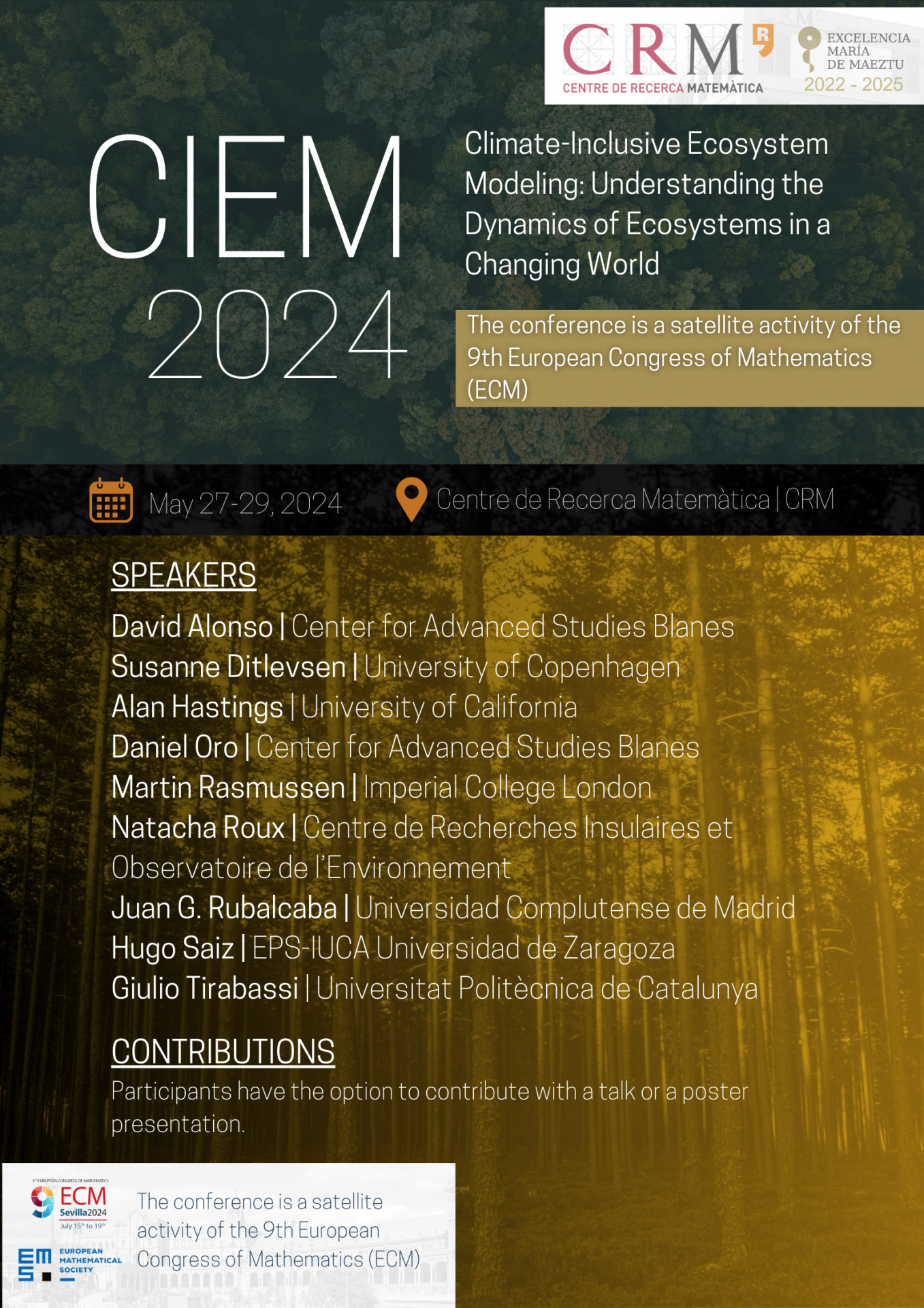
This Conference is a Satellite Activity of the 9th European Congress of Mathematics (ECM). Registered participants in the ECM can enjoy a 20% discount in the registration fee (please choose the applicable option when completing your registration).
REGISTRATION FEE
-
220€ Regular fee
-
175€ Reduced fee for participants of the 9th European Congress of Mathematics – Sevilla 2024
-
0€ for CRM researchers
Satellite ECM 2024 Conference: CIEM24
Sign into May 29, 2024
Climate-Inclusive Ecosystem Modeling: Understanding the Dynamics of Ecosystems in a Changing World
Dates: May 27-29, 2024
Location: Auditorium of Centre de Recerca Matemàtica
* Registration covers coffee breaks, lunchs, wine and cheese reception and a gala dinner.
SCHEDULE
SLIDES & PRESENTATIONS
Introduction
In a rapidly changing world, understanding the intricate relationships between climate and ecosystems has become more critical than ever. The “Climate-Inclusive Ecosystem Modeling: Understanding the Dynamics of Ecosystems in a Changing World (CIEM-24)” conference seeks to bring together researchers, scientists and stakeholders to explore and discuss cutting-edge approaches in modeling ecosystems, taking into account the profound influence of climate factors. The conference aims to address a wide range of topics, including theoretical ecology, ordinary and partial differential equations, autonomous and non-autonomous dynamical systems, multi-scale modelling, stochastic systems, among others, providing a comprehensive understanding of how climate change affects ecosystems and how ecosystem modeling can be enhanced to incorporate these effects.
Participants will delve into the following key areas:
1. Climate-Ecosystem Interactions: Explore the complex interactions between climate parameters and various ecosystems, such as forests, oceans, grasslands, and fresh waters. Understand how climate-induced changes, including temperature shifts, altered precipitation patterns, extreme weather events, and fires impact the structure and functioning of ecosystems, focusing on tipping points and regime shifts.
2. Advancements in Ecosystem Modeling: Showcase the latest advancements in ecosystem modeling techniques, including mathematical models, machine learning, remote sensing, and data-driven approaches. Examine how these models can simulate and predict ecosystem responses to climate change scenarios with greater accuracy and precision.
3. Impacts on Biodiversity and Species Distribution: Analyze the implications of climate change on biodiversity loss, species migration, and habitat alterations. Discuss strategies for preserving vulnerable ecosystems and mitigating potential ecological disruptions.
4. Resilience, Adaptation, and Prevention Strategies: Highlight successful cases of ecosystem resilience and adaptation in the face of climate challenges. Share best practices and innovative solutions that promote ecosystem sustainability and recovery. Model-based solutions to predict fires intensity and propagation.
5. Conservation and Restoration Efforts: Discuss conservation and restoration efforts based on climate-inclusive ecosystem modeling, focusing on ecosystem-based approaches that account for climate dynamics in restoration projects.
This conference aims to stimulate vibrant discussions, facilitate interdisciplinary collaborations, and promote the development of innovative methodologies and scientific works that consider climate as a pivotal factor in ecosystem dynamics. By uniting diverse perspectives and expertise, this conference endeavors to contribute significantly to the growing body of knowledge addressing the urgent need for sustainable management of ecosystems in an ever-changing world.
Organising Committee
Álvaro Corral | Centre de Recerca Matemàtica
Marc Jorba | Universitat Politècnica de Catalunya – Centre de Recerca Matemàtica
Josep Sardanyés | Centre de Recerca Matemàtica
Scientific Committee
Camila Artana | Sorbonne University
Marta Coll | Institut de Ciències del Mar
Álvaro Corral | Centre de Recerca Matemàtica
Jezabel Curbelo | Universitat Politècnica de Catalunya – Centre de Recerca Matemàtica
Ernest Fontich | Universitat de Barcelona – Centre de Recerca Matemàtica
Josep Sardanyés | Centre de Recerca Matemàtica
Blai Vidiella | Institute of Evolutionary Biology (CSIC-Universitat Pompeu Fabra)
SPEAKERS
Diffusion-induced patterns in stochastic ecosystem dynamics
David Alonso
Center for Advanced Studies Blanes, CEAB
His primary research interests lie in the interdisciplinary study of ecology and evolution on the basis of the integration of physics, mathematics, biology and computer simulation. In practice, I have been working essentially on two research topics: the evaluation of risks of spread and emergence of infectious diseases as a consequence of human-induced global environmental change and the study of the variety of mechanisms involved in the origins, maintenance and loss of species in ecological communities. Community ecology, population biology, infectious diseases, biodiversity research, climate change, environmental forcing, stochastic birth-death processes, non-linear interactions, self-organization, and complex systems are all common key-words on which my research agenda is focused.
ABSTRACT
To understand how climate shapes ecosystem dynamics, we need to explore the role and origins of stochasticity in ecological systems. In this talk, I will introduce the three general types of stochasticity: demographic, environmental, and individual heterogeneity. Using the Levins model, a classic ecological framework, I will demonstrate how these different forms of stochasticity influence ecosystem dynamics. By extending the Levins model, I will illustrate its fundamental significance in analyzing species-rich systems, eco-evolutionary dynamics, consumer-resource interactions and functional responses, and host-parasitoid interactions.
Although spatial environmental stochasticity, or spatial heterogeneity in environmental conditions, often underlies ecosystem dynamics, non-random spatial patterns in species distribution can also arise under uniform environmental conditions. These biologically-driven patterns, known as diffusion-induced or Turing patterns, were first described by Alan Turing, who showed that they develop from a diffusion-induced instability.
I will conclude my talk by examining a host-parasitoid interaction in a coffee plantation, presenting preliminary findings on the variety of spatial patterns produced by this system, and summarizing a general methodology for studying spatially-extended stochastic systems in an accessible manner.
Estimation of time to a tipping point
Susanne Ditlevsen
University of Copenhagen
Professor, Department of Mathematical Sciences, University of Copenhagen. Part of the Section Statistics and Probability Theory. Part of Data Science Laboratory.
MSc in mathematics in 1999 from la Universidad Nacional de Educacion a Distancia, Spain. MSc in statistics in 2000 from Department of Mathematical Sciences and PhD in biostatistics in 2005 from Department of Biostatistics, University of Copenhagen. Project-financed statistician 2000-2001, PhD student 2001-2004, Assistant Professor 2004-2007 and Associate Professor from February 2007 at the same place. Moved in September 2007 to the Department of Mathematical Sciences, as full professor from July 2011.
ABSTRACT
In recent years there has been an increasing awareness of the risks of collapse or tipping points in a wide variety of complex systems, ranging from human medical conditions, pandemics, ecosystems to climate, finance and society. They are characterized by variations on multiple spatial and temporal scales, leading to incomplete understanding or uncertainty in modelling of the dynamics. Even in systems where governing equations are known, such as the atmospheric flow, predictability is limited by the chaotic nature of the system and by the limited resolution in observations and computer simulations. In order to progress in analyzing these complex systems, assuming unresolved scales and chaotic dynamics beyond the horizon of prediction as being stochastic has proven itself efficient and successful. When complex systems undergo critical transitions by changing a control parameter through a critical value, a structural change in the dynamics happens, the previously statistically stable state ceases to exist and the system moves to a different statistically stable state. To establish under which conditions an early warning for tipping can be given, we consider a simple stochastic model, which can be considered a generic representative of many complex two state systems. We show how this provides a robust statistical method for predicting the time of tipping. The method is used to give a warning of a forthcoming collapse of the Atlantic meridional overturning circulation.
References: Peter D. Ditlevsen and Susanne Ditlevsen (2023), Warning of a forthcoming collapse of the Atlantic meridional overturning circulation. Nat Commun 14, 4254
Transient dynamics and ecological systems
Alan Hastings
University of California
Alan Hastings is a theoretical ecologist with broad interests. Current research focuses on invasive species, marine ecology and fisheries, transient dynamics in ecology, spatial ecology and experiments with Tribolium. He is a member of the National Academy of Sciences and a fellow of the American Academy of Arts and Sciences, the American Association for the Advancement of Science, the Ecological Society of America, and the Society for Industrial and Applied Mathematics. He is also a recipient of the Robert H. MacArthur Award from the Ecological Society of America.
ABSTRACT
Analyses of both models and data in ecology are still focused on equilibrium or long-term dynamics, with some notable exceptions. Although recent work on tipping points does include approaches based both on underlying changing environments and dynamics on different time scales, the possible situations where dynamics on different time scales are important are much more general. Using new mathematical ideas one can address questions of dynamics on ecological time scales, rather than longer times, and include other kinds of underlying environmental change. The importance of this way of analyzing ecological systems is clear in consideration of changing environments due to anthropogenic influences. The analyses demonstrate that there are wide ranges of ecological situations where standard analyses based on assuming asymptotic behavior are misleading. Additional cases where explicit time dependence is included in dynamics shows further complications. Different kinds of situations where long transient behavior is expected can be identified. In particular, adding space, which essentially makes systems very high dimensional, is often likely to lead to long transient dynamics. This work also, unfortunately, points out challenges in trying to identify systems where future sudden shifts in system state due to transients are going to occur, since transient behavior of a system with long transients will be asymptotic or long-term behavior of a corresponding system without transients. Examples of ecological systems illustrating the conclusions, including coral-algal-grazer systems will be discussed in light of the general theoretical results.
An empirical perspective of climate and complex responses of ecosystems
Daniel Oro
Center for Advanced Studies Blanes, CEAB
My research interests focus on animal ecology, and more particularly, on the influence of endogenous processes and exogenous stochastic forces driving spatial-temporal population dynamics. Ecological themes that attract my attention are, among others, life history strategies, density-dependence, interference competition within communities, predator-prey dynamics and interactions of biotic components of ecosystems with physical drivers. I am also interested in the non-linear responses of populations to all these processes, and in our ability to anticipate these responses for a better conservation of species and ecosystems.
ABSTRACT
I have spent 35 years of my professional career observing different ecological systems and how they respond to environmental change. In the beginning, it was obvious that stochastic climate played a crucial role in driving primary productivity and how this association pervaded into the entire ecosystem. It was not until several years later that I found out the importance of temporal and spatial scales for a better understanding of climate stochasticity and its effects on ecological processes. This included a necessary look at the geological time and evolutionary life histories involved in the complex responses of organisms to climate variability. I have ended up with the feeling of gathering a limited empirical knowledge of a range of organisms and ecosystems, and I struggle now to find out if there are good questions that remain unanswered. For instance, is there an evolutionary memory selected to tune the response of
organisms to climate stochasticity? How has climate cyclicity over the recent Quaternary affected life histories and the responses of organisms to this new climate regime? How the evolutionary pace of life has shaped the response of different organisms to climate stochasticity? I will summarise here my field experience over the years and how I deal with what remains between the trivial evidence (i.e. climate influences ecological processes) and the challenges of the unanswered (i.e. copying with the responses of complex ecosystems).
Transit times for nonautonomous compartmental systems with applications to ecology
Martin Rasmussen
Imperial College London
My research aims at the development of the Qualitative Theory of Nonautonomous and Random Dynamical Systems. In particular, I have made contributions to the following areas:
- stability and attractor theory,
- bifurcation theory,
- theory of invariant manifolds, and
- Morse decomposition theory.
ABSTRACT
Compartmental models play an important role to describe the dynamics of systems that involve mass movements between different types of pools. We develop a theory to analyse the average ages of mass in different pools in a linear compartmental system with time-dependent (i.e. non-autonomous) transfer rates, which involves transit times that characterise the average time a particle has spent in a particular pool. We apply our theoretical results to investigate a nine-dimensional compartmental system with time-dependent fluxes between pools modelling the terrestrial carbon cycle.
Joint work with Alan Hastings, George Chappelle, Matthew Smith, Yiqi Luo, Folashade Agusto, Benito Chen-Charpentier, Forrest Hoffman, Jiang Jiang, Katherine Todd-Brown, Ying Wang, Ying-Ping Wang.
Metamorphosis in marine fishes: the ecological function of thyroid hormones
Natacha Roux
Centre de Recherches Insulaires et Observatoire de l’Environnement (CRIOBE)
ABSTRACT
Most marine fishes have biphasic life cycle during which larvae disperse into the open ocean before coming back to a coastal habitat and renew adult population. This incredible journey represents a massive challenge for such tiny organisms that will have to not only orientate themselves, but also find food, escape predators, grow, and face massive external and internal changes to transform into juveniles that look like miniature adult. This transformation, is called metamorphosis and is under the control of thyroid hormones. It must occur during the transition between the oceanic and costal phase. Thyroid hormones are thus not only responsible for triggering metamorphosis, they in fact coordinate multiple processes to ensure that the outcoming juvenile will be equipped to adapt to its new habitat at the right time. Recent evidences are thus suggesting that thyroid hormones have an ecological function that is to ensure that developmental transitions are aligned with environmental transition. However, during such critical period, marine fish can be particularly vulnerable to external factors such as habitat quality, pollution, increase temperature, ocean acidification etc. We will present the experimental evidences supporting this model and discuss its implications.
Predicting organismal responses to climate change through biophysical modeling
Juan G. Rubalcaba
Universidad Complutense de Madrid
He is an evolutionary ecologist interested in understanding and predicting the responses of animals to environmental changes, particularly in the effect of climate on physiology, energy balance, and animal behavior. Animals exchange heat, water, oxygen, and nutrients with their environment, which determines the energy they can invest in growing and reproducing, their niche (where they can live), the evolution of functional traits such as body size and shape, and their responses to environmental changes. His work combines theoretical models and synthesis of empirical data to understand how the exchange of energy and matter determines these processes.
Focused on animal energetics, he works with different taxa and ecological systems including terrestrial and aquatic ectotherms and endotherms. For example, he is interested in the effects of climate on the thermal physiology and thermoregulatory behavior of reptiles and amphibians; the role of temperature and oxygen availability on the aerobic metabolism of fish; and how environmental conditions modulate the costs of thermoregulation and the energy balance of birds and mammals.
ABSTRACT
A core challenge of our time is to predict how organisms will respond to global environmental change. Yet most of our current predictive tools are correlative (statistical) methods that largely overlook the mechanisms underlying organism-environment interactions and thus have a limited capacity to extrapolate responses to unprecedented environmental scenarios. An emerging area of research is committed to developing mechanistic models to capture these interactions – a multidisciplinary endeavor integrating disparate fields such as thermodynamics, physiology, and evolutionary biology. A starting point towards achieving this integration has been to develop biophysical models describing the balances of heat, water and other aspects of energy and mass exchange between organisms and their environment and translate these into metrics of physiological performance and fitness. I will show recent advances in biophysical modeling and examples ranging from simple calculations of body temperature at specific times and locations, to broad-scale patterns including species distributions across both terrestrial and aquatic realms. I will highlight that biophysical models are opening new grounds of research and have the potential to transform ecology into a predictive science.
Back in time: palynologycal data to rebuild ecosystem shifts in the Holocene
Hugo Saiz
EPS-IUCA Universidad de Zaragoza
ABSTRACT
Forecasting the future impact of climate on ecosystems needs long time series data, which is often scarce for ecological communities. However, it is possible to use biological proxies to characterize past ecosystems. These proxies have several advantages. On the one hand, they spam over time periods including major climate changes. On the other, provide information about community composition, which allow inference about system level properties. Thus, it is possible to identify shifts in ecological communities and disentangle the drivers behind them. In this presentation I will show the preliminary results of our work on reconstructing ecological networks during the Holocene using the palynologycal records in mountain lakes. These networks show us the response of ecological communities to the conditions in their surroundings, including climate and human activities, providing valuable information about how ecosystems respond to global change drivers over time. Our results could help to anticipate how will ecosystems respond to climate in the near future, predict the arrival of major shifts, and highlight the value of ancient biological proxies for climate change research.
Applications of Spatial Permutation Entropy to the study of spatially extended ecosystems
Giulio Tirabassi
Universitat Politècnica de Catalunya
ABSTRACT
Understanding and predicting abrupt ecological shifts in spatially extended ecosystems are vital for environmental management. Ecosystems like those in the North Atlantic Ocean and semiarid regions can undergo significant transitions due to rapid changes in key indicators. Previous research highlights the utility of spatial correlation in forecasting these tipping points, but early identification remains challenging due to factors like data resolution and noise.
It has been shown that the spatial permutation entropy (PE) can detect early warning signals in spatiotemporal data. Here, by analyzing the temporal variability of spatial indicators, specifically spatial correlation and PE, we aim to identify patterns signaling ecological shifts. We apply our approach to North Atlantic chlorophyll levels and semiarid vegetation data, along with model simulations.
CONTRIBUTIONS
Participants have the option to contribute with a talk or a poster presentation. The poster boards that are available at the CRM are DIN A0 format (1189×841 mm). Any poster size within these limits is fine.
To apply, please select the relevant option during the registration process.
- Deadline for submission: April 28th, 2024.
INVOICE/PAYMENT INFORMATION
IF YOUR INSTITUTION COVERS YOUR REGISTRATION FEE: Please note that, in case your institution is paying for the registration via bank transfer, you will have to indicate your institution details and choose “Transfer” as the payment method at the end of the process.
UPF | UB | UPC | UAB
*If the paying institution is the UPF / UB/ UPC / UAB, after registering, please send an email to comptabilitat@crm.cat with your name and the institution internal reference number that we will need to issue the electronic invoice. Please, send us the Project code covering the registration if needed.
Paying by credit card
IF YOU PAY VIA CREDIT CARD but you need to provide the invoice to your institution to be reimbursed, please note that we will also need you to send an email to comptabilitat@crm.cat providing the internal reference number given by your institution and the code of the Project covering the registration (if necessary).
LODGING INFORMATION
ON-CAMPUS AND BELLATERRA
BARCELONA AND OFF-CAMPUS
|
For inquiries about this event please contact the Scientific Events Coordinator Ms. Núria Hernández at nhernandez@crm.cat
|












